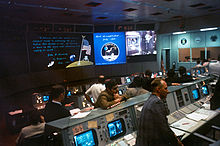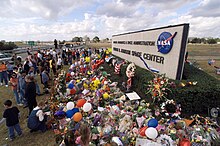Lyndon B. Johnson Space Center
The Johnson Space Center (officially in English Lyndon B. Johnson Space Center or JSC; in Spanish: Lyndon B. Johnson Space Center) is a NASA facility for manned space activities, located in southeast Houston, Texas, United States. It was built on land donated by Rice University.
The JSC houses the mission control center (MCC-H), and the control center of NASA which coordinates and supervises all manned flights in the United States. MCC-H directed all shuttle missions and activities, and currently oversees the International Space Station. He is also in charge of the White Sands Missile Range, in New Mexico, which served as an emergency landing site for the space shuttle, as well as a coordination facility for the vehicle that was to replace it from 2010, called Project Constellation.
NASA astronaut practices are held at JSC in the Sonny Carter Training Area, which includes the Neutral Buoyancy Laboratory, a sizable pool that is nearly 23.4 million liters of water where astronauts train to do additional tasks, such as driving vehicles in simulated weightlessness.
The JSC employs around 3,000 staff, including 110 astronauts. The workforce consists of approximately 15,000 workers and contractors. Of the 15 companies working at the JSC, the largest is the United Space Alliance, which comprises about 40 percent of the JSC employees. From May 2018 to 2021, the center's director was Mark S. Geyer, who retired after being diagnosed with cancer, with Vanessa E. Wyche, until then deputy director, taking over the position. Geyer was the twelfth director. of the JSC, the first was Robert Gilruth.
One of the space artifacts on display at the Johnson Space Center is the Saturn V rocket, complete with the exception of the ring between the S-IC and S-II stages, and the cowling between the S-II stages and from S-IVB. This Saturn is built from real wreckage. Also on display is a real Apollo vehicle, which was supposed to fly on the canceled Apollo 19 mission.
History
Robert Gilruth, leader of the space task force, became the first director of NASA's manned spacecraft center in 1961.
The Johnson Space Center traces its origins to NASA's Space Task Group (STG). Beginning on November 5, 1958, engineers at the Langley Research Center under the direction of Robert Gilruth directed Project Mercury and subsequent manned space programs. The STG originally reported to the Goddard Space Flight Center organization that its original staff consisted of a total of 45 staff, including 37 engineers, and eight secretaries, called "human computers" because they performed calculations on mechanical adding machines. In 1959, the center added 32 Canadian engineers who had been made redundant by the cancellation of the Avro Canada CF-105 Arrow project. NASA's first administrator, T. Keith Glennan, realized that the growth of the space program in The US would make the STG outperform the Langley and Goddard hubs and require its own location. On January 1, 1961, a memorandum was drawn up to his as yet undesignated successor, later found to be James E. Webb, recommending that a new site be chosen. Later that year, when President John F. Kennedy established the With the goal of landing a man on the Moon by the end of the decade, it became clear that Gilruth would need a larger organization to lead the Apollo Program, with new testing facilities and research laboratories.
Research
The Johnson Space Center leads scientific and medical research programs related to NASA human spaceflight. The technologies developed for these space flights are used today in various areas of medicine, energy, transportation, agriculture, communications, and electronics.
The Scientific Office for Astromaterials Research and Exploration (ARES) conducts physical science research at the center. ARES directs and manages all functions and activities of scientists conducting basic research in Earth, planetary, and space sciences. ARES scientists and engineers support human and robotic spaceflight programs. ARES's responsibilities also include interaction with the mission assurance and safety office and human spaceflight programs.
The JSC has an agreement with the Baylor College of Medicine's National Institute for Space Biomedical Research to study the health risks associated with long-duration spaceflight. The studies enable biomedical research in support of long-term human presence in space, studies that were initiated by the Institute and NASA's Human Research Program.
The pre-respiratory reduction program is a special study and research program, which the JSC is developing to improve the safety and efficiency of spacewalks from the International Space Station.
Buildings
All JSC buildings are numbered and not named. A partial list of the buildings and what they contain is as follows:
- Building 1: JSC Headquarters, including senior management offices and JSC director.
- Building 2: Office of Public Affairs, including video production and audio processing facilities.
- Building 4: Office building, including astronauts and flight directors.
- Building 5: Includes the space shuttle simulator.
- Building 8: Clinic and sanitary material. Historical files (such as movies and photographs) of NASA.
- Building 9: Cab models and payload compartment of the space shuttle
- Building 30: Contains the mission control center including the flight command rooms that support the space shuttle and the international station.
- Building 31: In it are installed the vacuum compartments for the test equipment.
- Building 44: In this building are the monitoring, communications and development laboratories.
Contenido relacionado
Demography
Bronchioloalveolar carcinoma
Condenser

